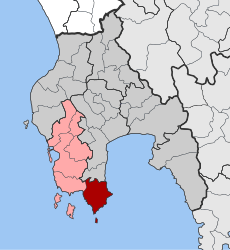Koroni
|
Koroni Κορώνη |
|
|---|---|
 |
|
| Coordinates: 36°47′N 21°57′E / 36.783°N 21.950°ECoordinates: 36°47′N 21°57′E / 36.783°N 21.950°E | |
| Country | Greece |
| Administrative region | Peloponnese |
| Regional unit | Messenia |
| Municipality | Pylos-Nestoras |
| • Municipal unit | 105.163 km2 (40.604 sq mi) |
| Lowest elevation | 0 m (0 ft) |
| Population (2011) | |
| • Municipal unit | 4,366 |
| • Municipal unit density | 42/km2 (110/sq mi) |
| Community | |
| • Population | 1,409 (2011) |
| Time zone | EET (UTC+2) |
| • Summer (DST) | EEST (UTC+3) |
| Postal code | 24x xx |
| Area code(s) | 272x0 |
| Vehicle registration | XA |
| Website | www.korone.gr |
Koroni or Corone (Greek: Κορώνη) is a town and a former municipality in Messenia, Peloponnese, Greece. Since the 2011 local government reform it is part of the municipality Pylos-Nestoras, of which it is a municipal unit. Known as Corone by the Venetians and Ottomans, the town of Koroni (pop. 1,397 in 2011) sits on the southwest peninsula of the Peloponnese on the Gulf of Messinia in southern Greece 45 minutes southwest of Kalamata. The town is nestled on a hill below an impressive Venetian castle and reaches to the edge of the gulf. The town was the seat of the former municipality of Koróni, which has a land area of 105.163 km² and a population of 4,366 (2011 census). The municipal unit consists of the communities Akritochori, Charakopio, Chrysokellaria, Falanthi, Kaplani, Kompoi, Koroni, Vasilitsi, Vounaria and Yameia. It also includes the uninhabited island of Venétiko.
The town was founded in ancient times. The 2nd century Greek geographer Pausanias in his book Messeniaka reports the original location of Koroni at modern Petalidi, a town a few kilometers north of Koroni. He also reports many temples of Greek gods and a copper statue of Zeus. In the centuries that followed the town of Koroni moved to its current location, where the ancient town of Asini had once stood. In the 6th and 7th centuries AD, the Byzantines built a fortress there.
The town appears for the first time as a bishopric in the Notitiae Episcopatuum of the Byzantine Emperor Leo VI the Wise, in which it appears as a suffragan of the See of Patras. Surviving seals give the names of some of its Greek bishops. The Greek eparchy was suppressed in the 19th century as part of an ecclesiastical reorganization after Greece gained its independence.
...
Wikipedia


